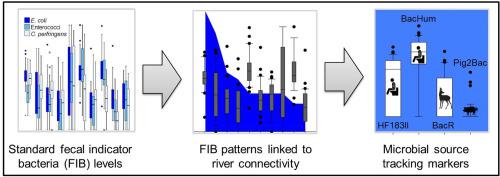Water Research ( IF 12.8 ) Pub Date : 2020-07-05 , DOI: 10.1016/j.watres.2020.116132 Christina Frick 1 , Julia Vierheilig 2 , Theodossia Nadiotis-Tsaka 3 , Simone Ixenmaier 4 , Rita Linke 4 , Georg H Reischer 4 , Jürgen Komma 5 , Alexander K T Kirschner 6 , Robert L Mach 7 , Domenico Savio 8 , Dagmar Seidl 3 , Alfred P Blaschke 9 , Regina Sommer 10 , Julia Derx 9 , Andreas H Farnleitner 8

|
A novel concept for fecal pollution analysis was applied at alluvial water resources to substantially extend the information provided by fecal indicator bacteria (FIB). FIB data were linked to river connectivity and genetic microbial source tracking (MST). The concept was demonstrated at the Danube River and its associated backwater area downstream of the city of Vienna, using a comprehensive 3-year data set (10 selected sites, n = 317 samples). Enumeration of Escherichia coli (ISO 16649-2), intestinal enterococci (ISO 7899-2) and Clostridium perfringens (ISO 14189) revealed a patchy distribution for the investigation area. Based on these parameters alone a clear interpretation of the observed fecal contamination patterns was not possible. Comparison of FIB concentrations to river connectivity allowed defining sites with dominating versus rare fecal pollution influence from the River Danube. A strong connectivity gradient at the selected backwater sites became obvious by 2D hydrodynamic surface water modeling, ranging from 278 days (25%) down to 5 days (<1%) of hydraulic connectivity to the River Danube within the 3-year study period. Human sewage pollution could be identified as the dominating fecal source at the highly connected sites by adding information from MST analysis. In contrast, animal fecal pollution proofed to be dominating in areas with low river connectivity. The selection of genetic MST markers was focusing on potentially important pollution sources in the backwater area, using human (BacHum, HF183II), ruminant (BacR) and pig (Pig2Bac) -associated quantitative PCR assays. The presented approach is assumed to be useful to characterize alluvial water resources for water safety management throughout the globe, by allocating fecal pollution to autochthonous, allochthonous, human or animal contamination components. The established river connectivity metric is not limited to bacterial fecal pollution, but can be applied to any type of chemical and microbiological contamination.
中文翻译:

通过将标准的粪便指示菌与河流的连通性和遗传微生物源追踪联系起来,阐明冲积水资源中的粪便污染模式。
粪便污染分析的一种新颖概念被应用于冲积水资源,以大大扩展粪便指示菌(FIB)提供的信息。FIB数据与河流连通性和遗传微生物源跟踪(MST)相关联。使用全面的3年数据集(10个选定地点,n = 317个样本),在多瑙河及其相关的维也纳市下游回水区进行了论证。列举大肠杆菌(ISO 16649-2),肠球菌(ISO 7899-2)和产气荚膜梭菌(ISO 14189)揭示了调查区域的零散分布。仅基于这些参数,就不可能对观察到的粪便污染模式进行清晰的解释。通过将FIB浓度与河流连通性进行比较,可以确定多瑙河对粪便污染的影响占主要地位的地区。通过二维水动力地表水建模,在选定的回水点处的连通性梯度很明显,在3年研究期内,与多瑙河的水力连通性从278天(25%)下降到5天(<1%)。通过添加来自MST分析的信息,可以将人类污水污染确定为高度相连地点的主要粪便来源。相反,动物粪便污染在河流连通性低的地区被证明是主要的。使用人类(BacHum,HF183II),反刍动物(BacR)和猪(Pig2Bac)相关的定量PCR分析法,选择基因MST标记的重点是回水地区潜在的重要污染源。通过将粪便污染分配给本地,外源,人类或动物污染成分,假定所提出的方法可用于表征冲积水资源,用于全球范围内的水安全管理。既定的河流连通性度量标准不仅限于粪便细菌污染,还可以应用于任何类型的化学和微生物污染。通过将粪便污染分配给本地,外源,人类或动物污染成分,假定提出的方法可用于表征冲积水资源,用于全球范围内的水安全管理。既定的河流连通性度量标准不仅限于粪便细菌污染,还可以应用于任何类型的化学和微生物污染。通过将粪便污染分配给本地,外源,人类或动物污染成分,假定所提出的方法可用于表征冲积水资源,用于全球范围内的水安全管理。既定的河流连通性度量标准不仅限于粪便细菌污染,还可以应用于任何类型的化学和微生物污染。


























 京公网安备 11010802027423号
京公网安备 11010802027423号